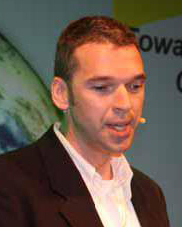Shifting horizons: Feeding the globe in 2050

It is not hard these days to get worried about planet Earth’s perspectives. Shifting Horizons was this year’s theme at the fifth edition of Agri Vision, organised by global animal nutrition company Nutreco, in Noordwijk-aan-Zee, the Netherlands, 16-18 June. Heavy challenges are ahead when it comes down to feeding mankind, especially in the years to come.
©
By Vincent ter Beek
©
To start off with, some figures were given by Wout Dekker, CEO, Nutreco. He put the cat among the pigeons, quoting United Nations data which prospect 9.2 billion people living on earth in the year 2050, in comparison to 6.9 billion in 2010. Adding that more people will be wealthy, the demand for proteins for consumption will rise tremendously. In other words, he said, quoting FAO, “More food will have to be produced over the next decades than has been produced during the past 10,000 years combined.” In short: Four extra planet earths would be
needed at that time, to feed the world. How to prepare for that – preferably in a sustainable way?
©
©
Meeting needs
A range of scientists and captains of industry shared their vision on this question, all from their own angle and profession. Prof Dr André Faaij, professor of energy system analysis at the University of Utrecht, the Netherlands, studies how the world’s energy sources can be used in a more efficient way and hence claims that ‘this world can produce food for 40 billion people, more than meeting our 2050 needs’. Key to this, in his view, is the interlinking between agriculture and poverty as approximately 70% of the world’s poor are living in a rural setting. Hence, he said, investment in agriculture is essential, with increased efficiency in water use, less land, protection of soils and better incomes. Bioenergy can get the money and sustainable economic activity into the rural regions and governance is key.
©©
The ‘forgotten’ continent Africa may soon become very important in that sense – and several speakers mentioned Africa as the place in the world not to forget for future generations. The continent, however, contains many different countries in various stages of political and economic development. Thorleif Enger, chairman of the Yara Foundation and former CEO of Yara International, emphasised the need for©investments in Africa to make progress sustainable. “Foreign aid leads to corruption and dependency. We have to make Africans believe in their future, make more investments in agriculture and encourage entrepreneurship.”
©
©
Genetic potential
‘Sustainable precision livestock farming’ was introduced by Prof Dr Leo den Hartog, director agriculture R&D and Quality Affairs at Nutreco. This, in his view, is a synergy of improving all potentials in both animals and animal production. Elements like nutrigenomics, full system control and farm automation play a large part in order to create a situation in which animals make the most of their genetic potential by growing more efficiently on better crops.
©
Not only for improving livestock performance efficiency would it be good to take a critical look at the way crops are produced. Using genetically modified (GM) crops for animal feed allows producers to harvest more grains from every square km anywhere in the world, meaning that production will be more efficient. Robert Berendes, member of the executive committee and global head of development at Syngenta International, therefore explained and re-emphasised the necessity for the European Union to stop blocking the use of GM feeds.
©
©
Reinforcing the GM lobby even came from an unexpected corner as the World Wide Fund (WWF) also launched a plea in favour of the cultivation of GM crops. Dr Jason Clay, senior vice president with the WWF, mentioned regions like Africa, potentially suffering from the ever-increasing demand for areas for crop cultivation. Clay reminded the world of the amount of wildlife still existing. If the world needs more surface to cultivate its
‘ordinary’ crops, areas for nature and animals in the wild will decrease sharply. Hence: “If we don’t do anything,” he said, “by 2050 no wildlife will be left on this planet.” PP
©
For more coverage and information on all speakers, please check ‘Events’ at the Photo and Video section at www.pigprogress.net
©
Source: Pig Progress magazine 25.7











